PR
X
キーワードサーチ
▼キーワード検索
カレンダー
サイド自由欄
鉄道模型・鉄道グッズリンク
鉄道関連書籍リンク
時刻表最新号
JTB時刻表

JR時刻表

鉄道雑誌最新号
鉄道ファン

鉄道ジャーナル

鉄道ピクトリアル

鉄道ダイヤ情報

Rail Magazine
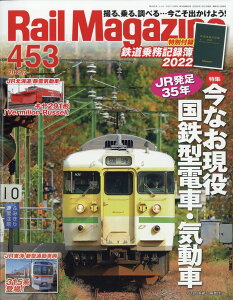
RM MODELS

j train

とれいん

鉄道模型趣味

N

旅と鉄道

楽天トラベルで旅に出よう

鉄道関連書籍リンク
時刻表最新号
JTB時刻表

JR時刻表

鉄道雑誌最新号
鉄道ファン

鉄道ジャーナル

鉄道ピクトリアル

鉄道ダイヤ情報

Rail Magazine

RM MODELS

j train

とれいん

鉄道模型趣味

N

旅と鉄道

楽天トラベルで旅に出よう
コメント新着
テーマ: 鉄道(23060)
カテゴリ: 鉄道日記
ロマンスカーミュージアムは2021(令和3)年4月19日に開館した、小田急ロマンスカーを中心に展示する小田急電鉄の鉄道博物館。
開館直後は新型コロナウィルス禍の最中にあったことから、Webサイトでの事前予約が必要だったが、2022(令和4)年10月より事前予約なしで入館できるようになった。
ミュージアムは小田原線・相鉄本線とJR東日本相模線双方の海老名駅をつなぐ歩道橋「ビナウォーク」に直結している。この日は日曜日だったこともあってか、家族連れを中心に多くの人たちがビナウォーク上に入館待ちの行列を作っていた。
僕が最初に向かったのは、ミュージアム併設の「ROMANCECAR MUSEUM CLUBHOUSE」。ミュージアム開館と同時に開店したが、2023(令和5)年5月31日で閉店してしまうことが先日発表された。
ここで僕が食べたかったものが、「クールケーキと日東紅茶のセット」。
クールケーキといえば、往年のロマンスカーの車内販売サービス「走る喫茶室」の名物スイーツだった、アイスクリームをスポンジ生地で包んだロールケーキのようなお菓子。1993(平成5)年に日東紅茶(三井農林)が「走る喫茶室」サービスから撤退するまで同サービスで提供されていた。僕は「走る喫茶室」時代にクールケーキを食べたことがなかったため、ここでぜひ1度食べたかった。
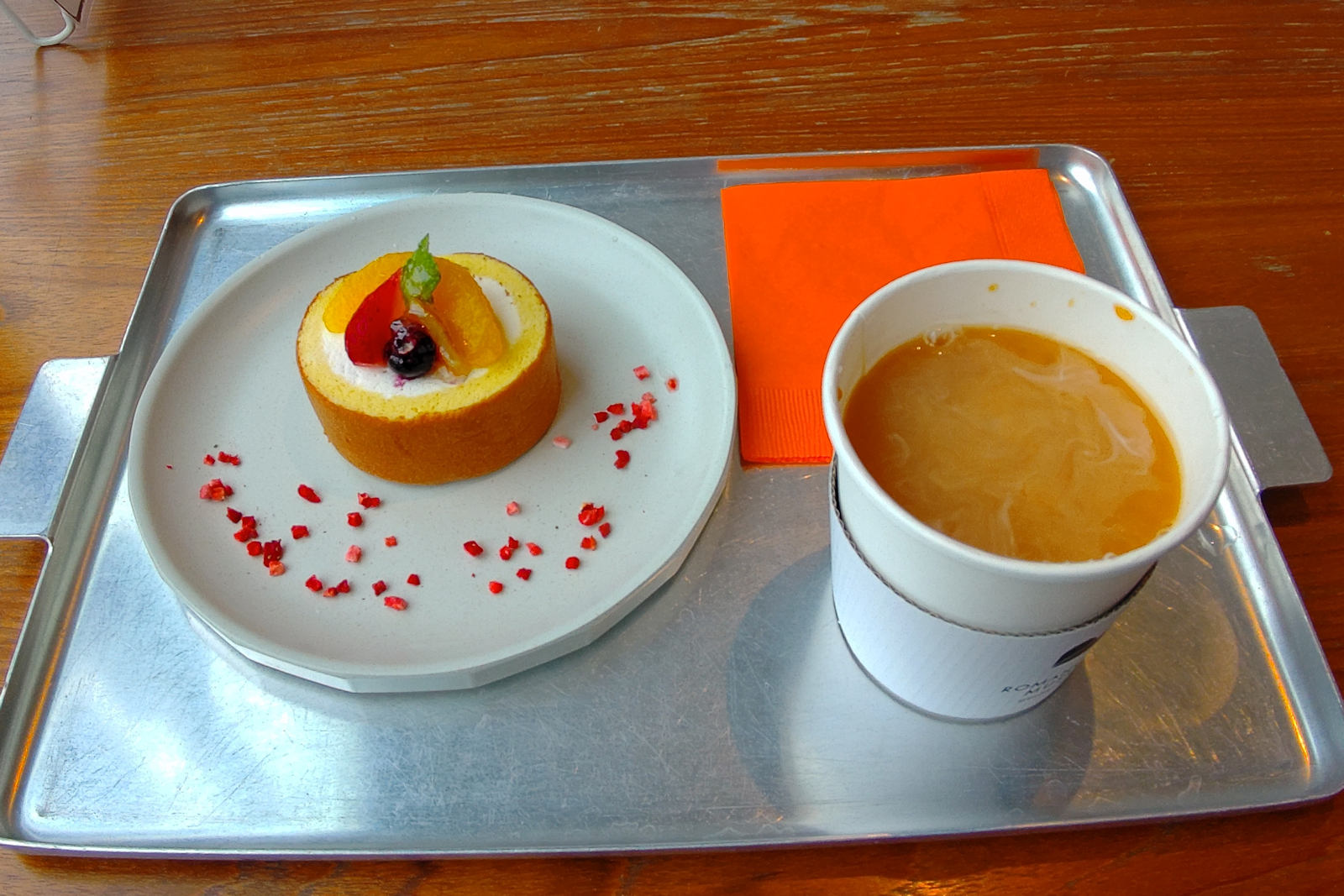
クールケーキと日東紅茶のセット a piece of "Cool Cake" Swiss roll and a cup of tea
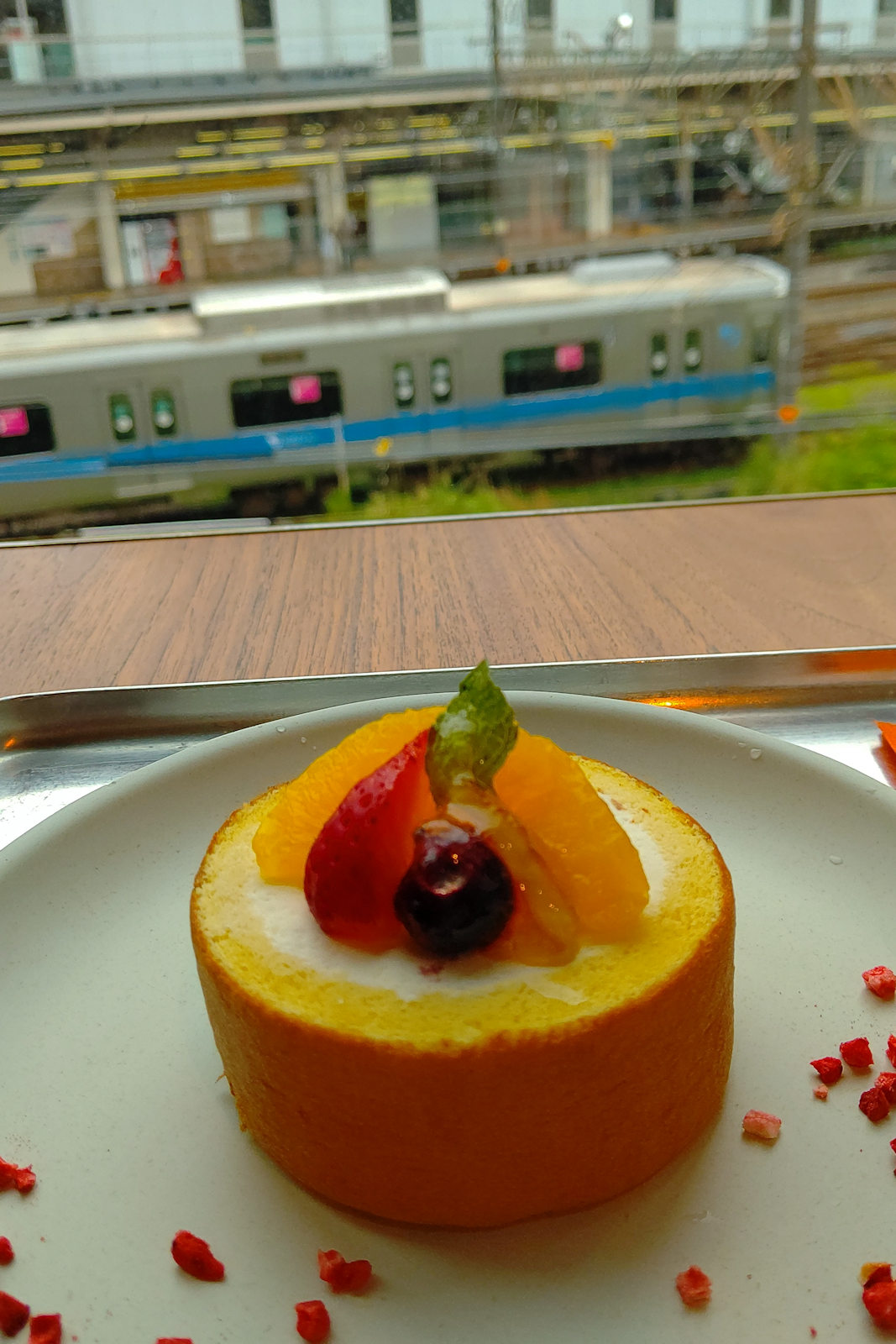
クールケーキと海老名検車区に入庫中の小田急3000形電車 a piece of "Cool Cake" Swiss roll and Odakyu 3000 Series in Ebina Railyard
クールケーキはふんわりとしたスポンジケーキと固めのアイスクリームのコントラストが印象的だった。
改めてミュージアムへ。入り口からエスカレーターを下り1階へ着くと、小田急線を初めて走った車両である小田原急行鉄道1形電車が出迎えてくれる「ヒストリーシアター」エリア。
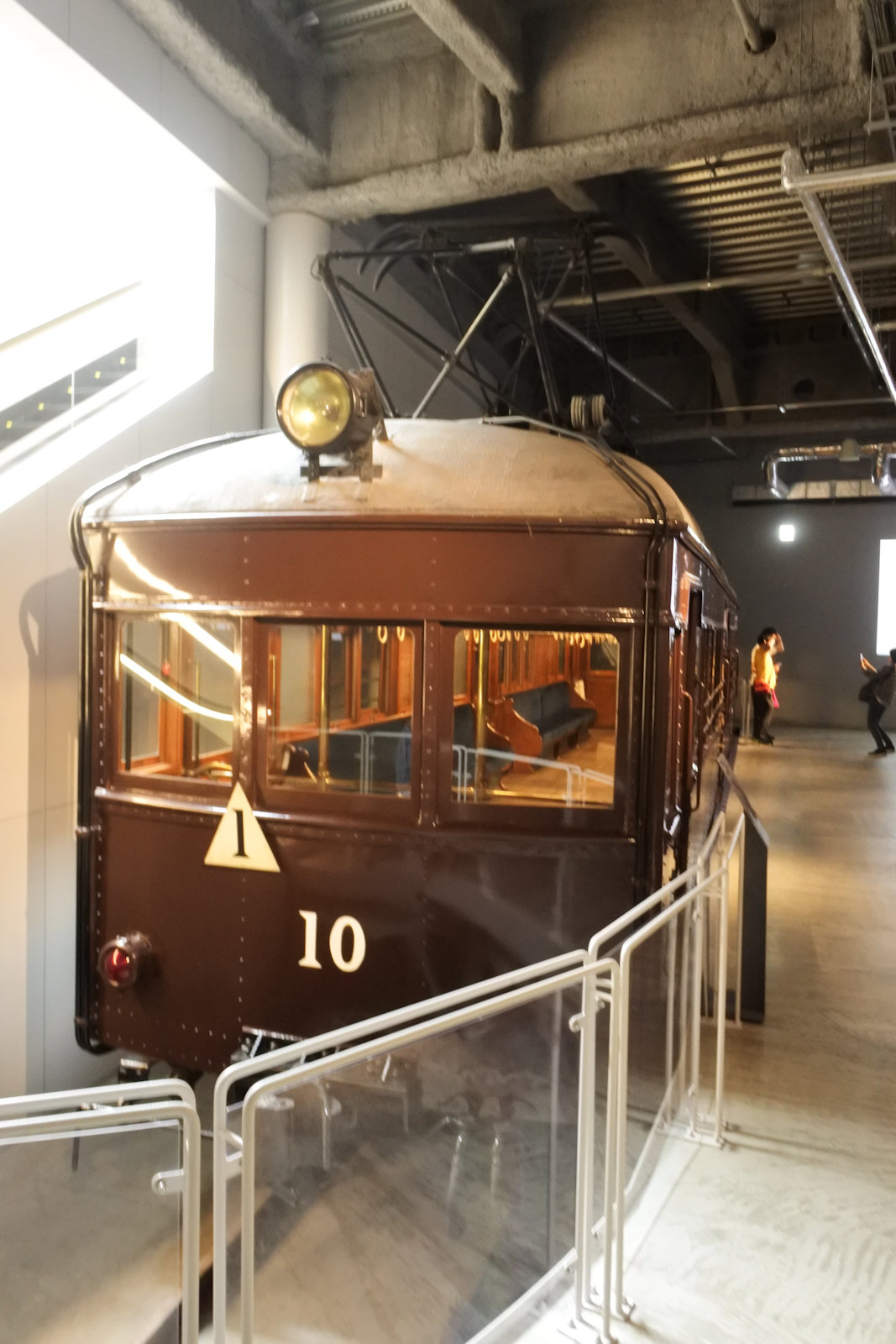
「ヒストリーシアター」に展示されている小田原急行鉄道1形電車 Odawara Kyuko Railway 1 Series exhibited in "History Theater" area
そこから右に進み、廊下を抜けると、メイン展示の「ロマンスカーギャラリー」へ。初代3000形電車、3100形電車、7000形電車の3車種がお出迎え。
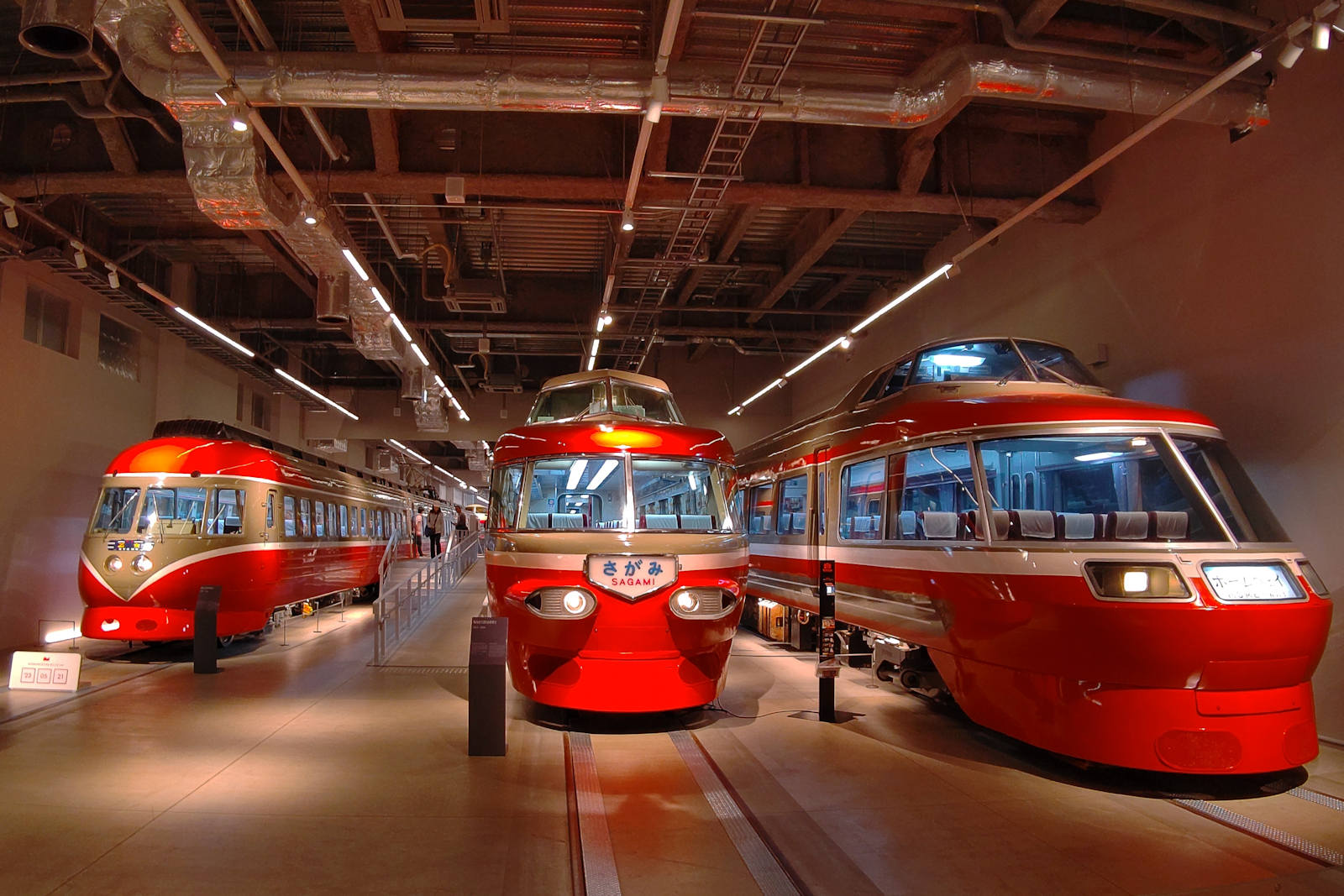
「ロマンスカーギャラリー」に展示されている初代3000形電車(左)、3100形電車(中央)、7000形電車(右) First 3000 Series (left), 3100 Series (centre), and 7000 Series (right) exhibited in "Romancecar Gallary" area
初代3000形は、開館以前は海老名検車区にある屋根付きの車庫で大切に保存されていたもので、イベント時のみにその姿を見ることができた、いわば“秘仏”のような存在だった。
僕が初代3000形を見るのは、最後の“御開帳”だった2019(令和元)年に開催された「ファミリー鉄道展」以来のことだ。ミュージアムでは3両に短縮されたものの、往年の輝かしさはその頃から変わっていないように見えた。
3100形も3両が展示されている。初代3000形、3100形とも、「ヒストリーシアター」からつながる通路寄り(新宿方)から数えて2両目の側扉周辺のデッキ部分のみ車内に入れ、そこから車内全体を見渡せる。
7000形は先頭車両1両のみの展示で、先頭部分のみ外から見学可能。
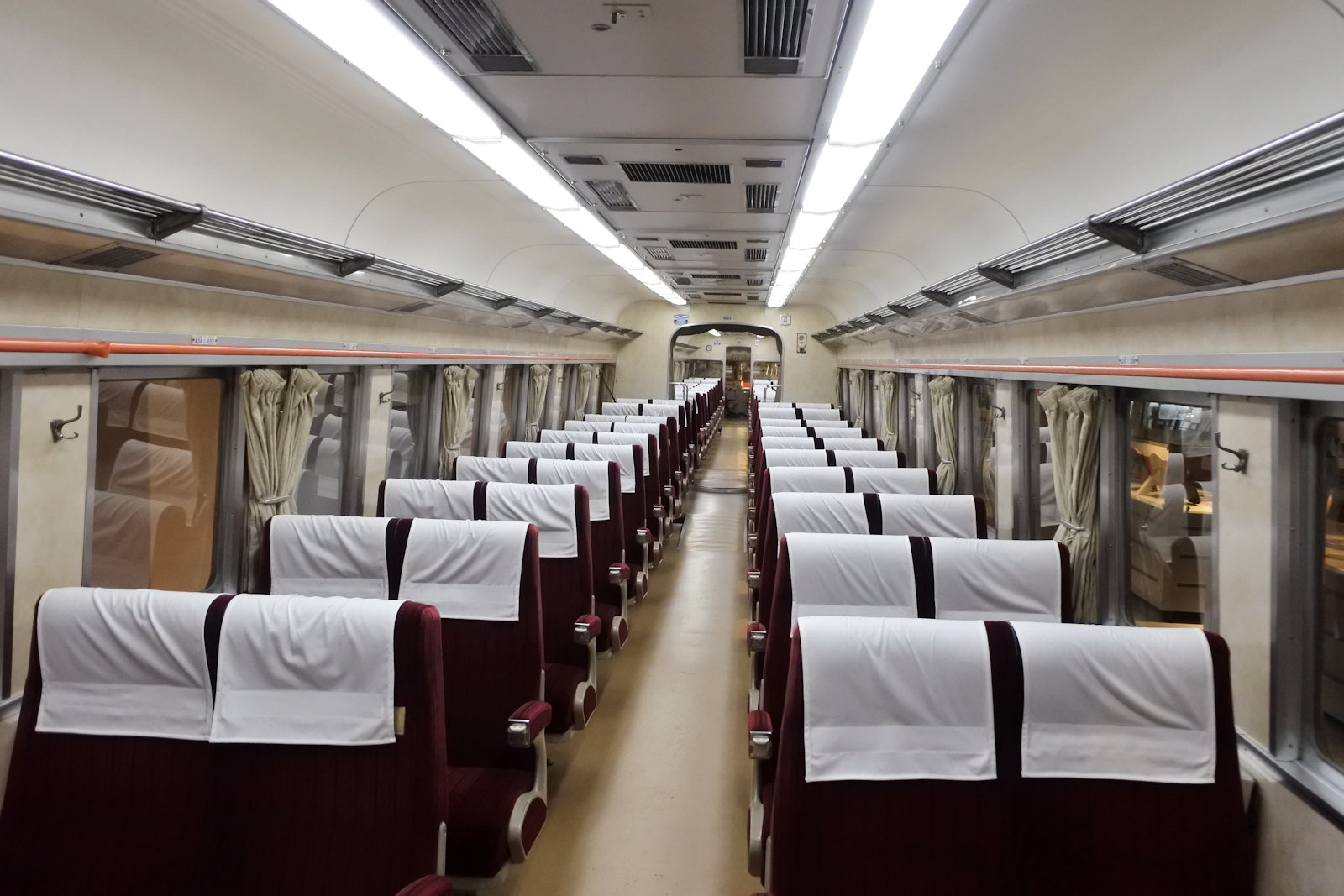
初代3000形電車車内 Interior of first 3000 Series
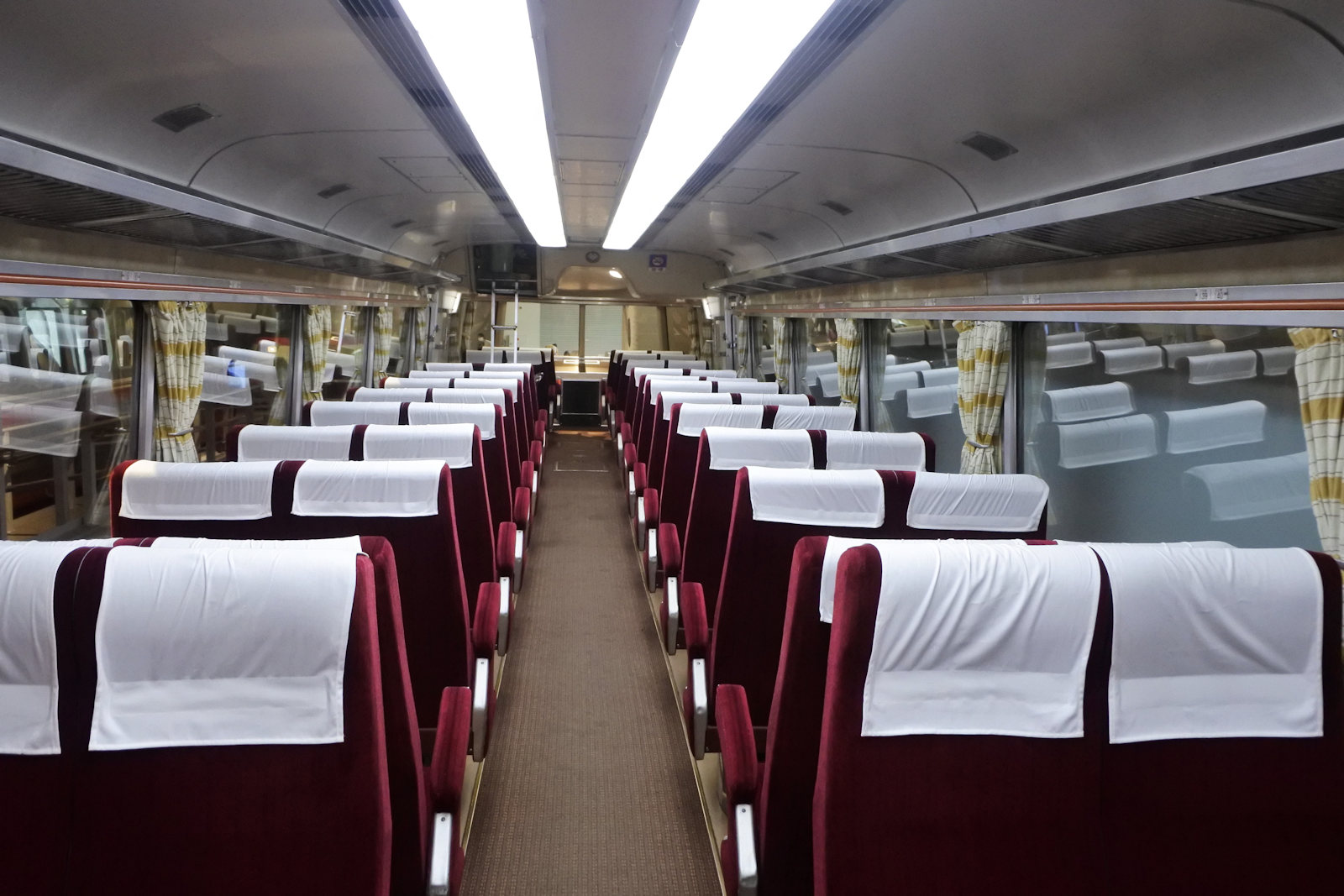
3100形電車車内 Interior of 3100 Series
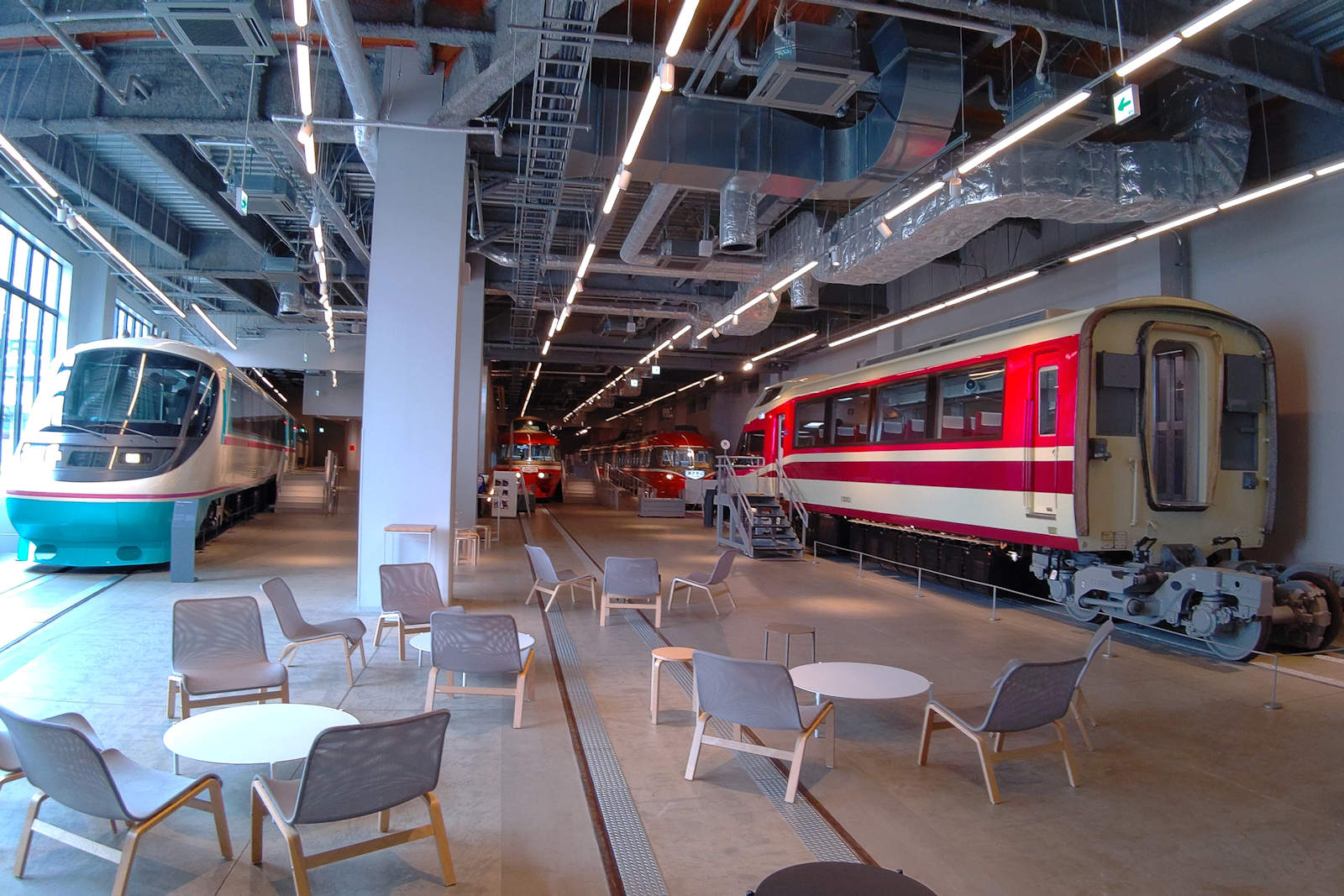
「ロマンスカーギャラリー」に展示されている20000形電車(左)と10000形電車(右) 20000 Series (left) and 10000 Series (right) exhibited in "Romancecar Gallary" area
10000形電車は1両の展示で、多くの人が憧れた展望席にも座れる。
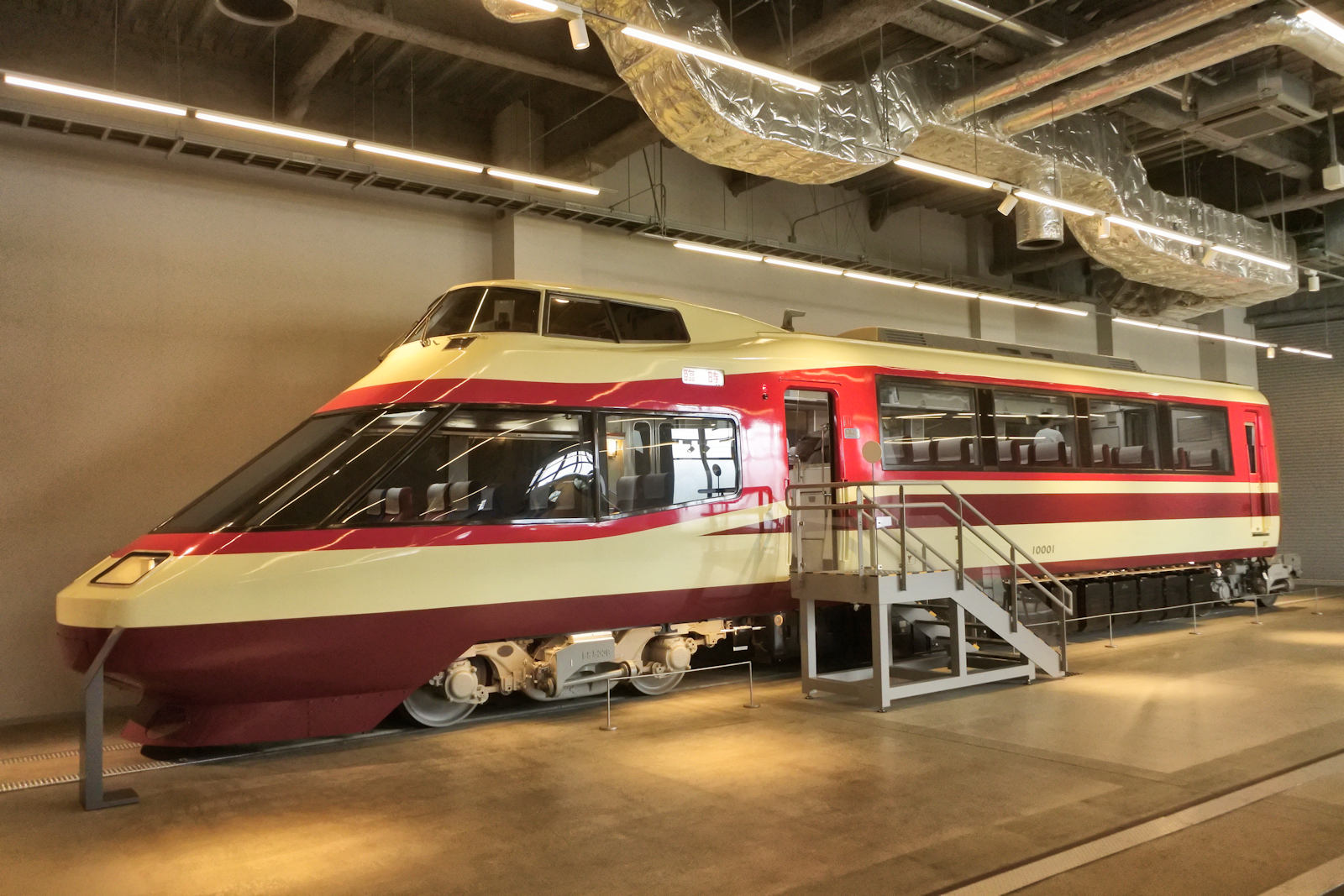
10000形電車側面 Side view of 10000 Series
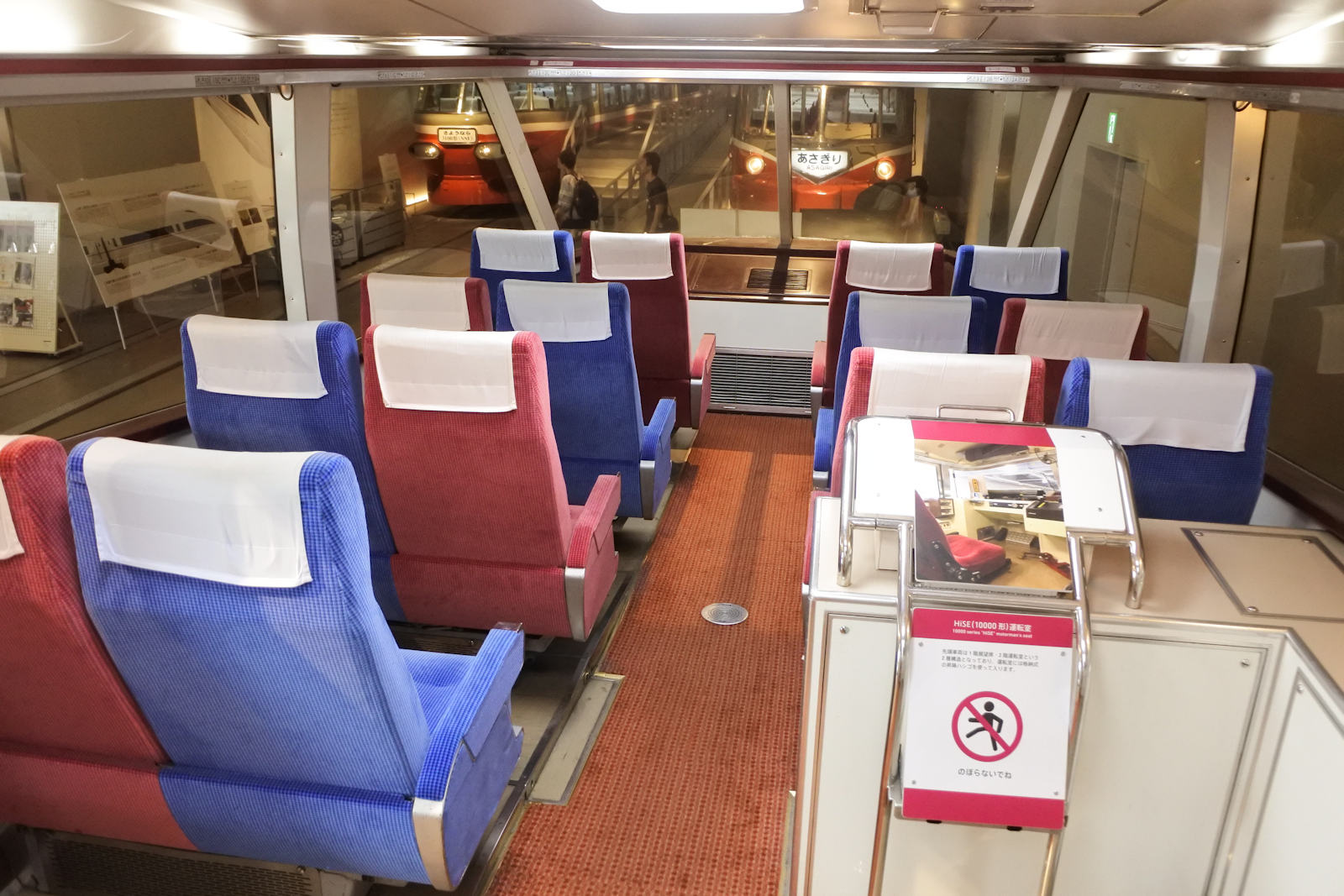
10000形電車車内 Interior of 10000 Series
特徴的な連接台車(車両の連結部分に2両を橋渡しするように履く台車)も間近に見ることができる。
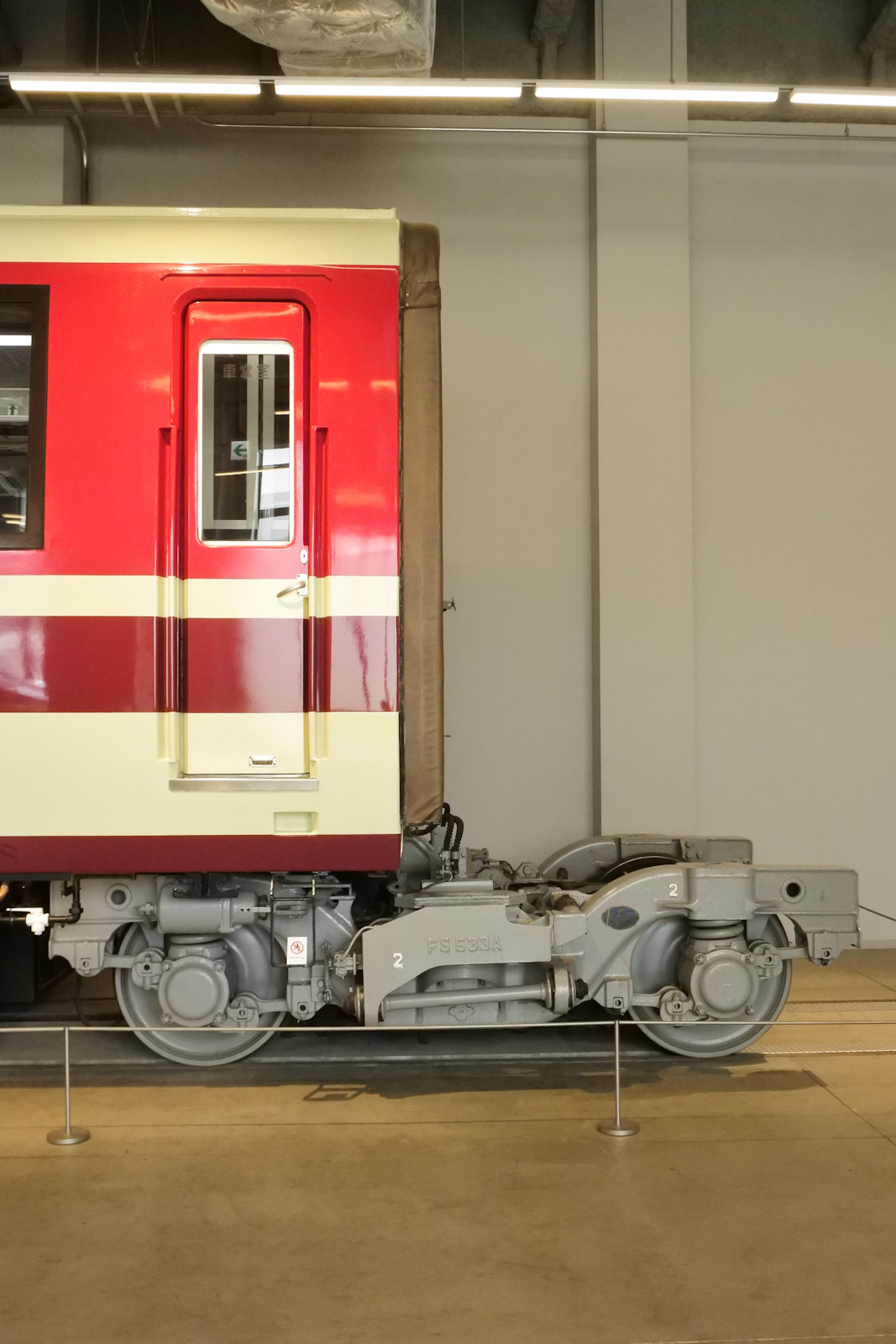
20000形は2両の展示で、1両は先頭車両、もう1両はダブルデッカー車両。先頭車両は座席に座れ、ダブルデッカー車両は車販カウンターと1階通路・2階座席手前まで見学できる。
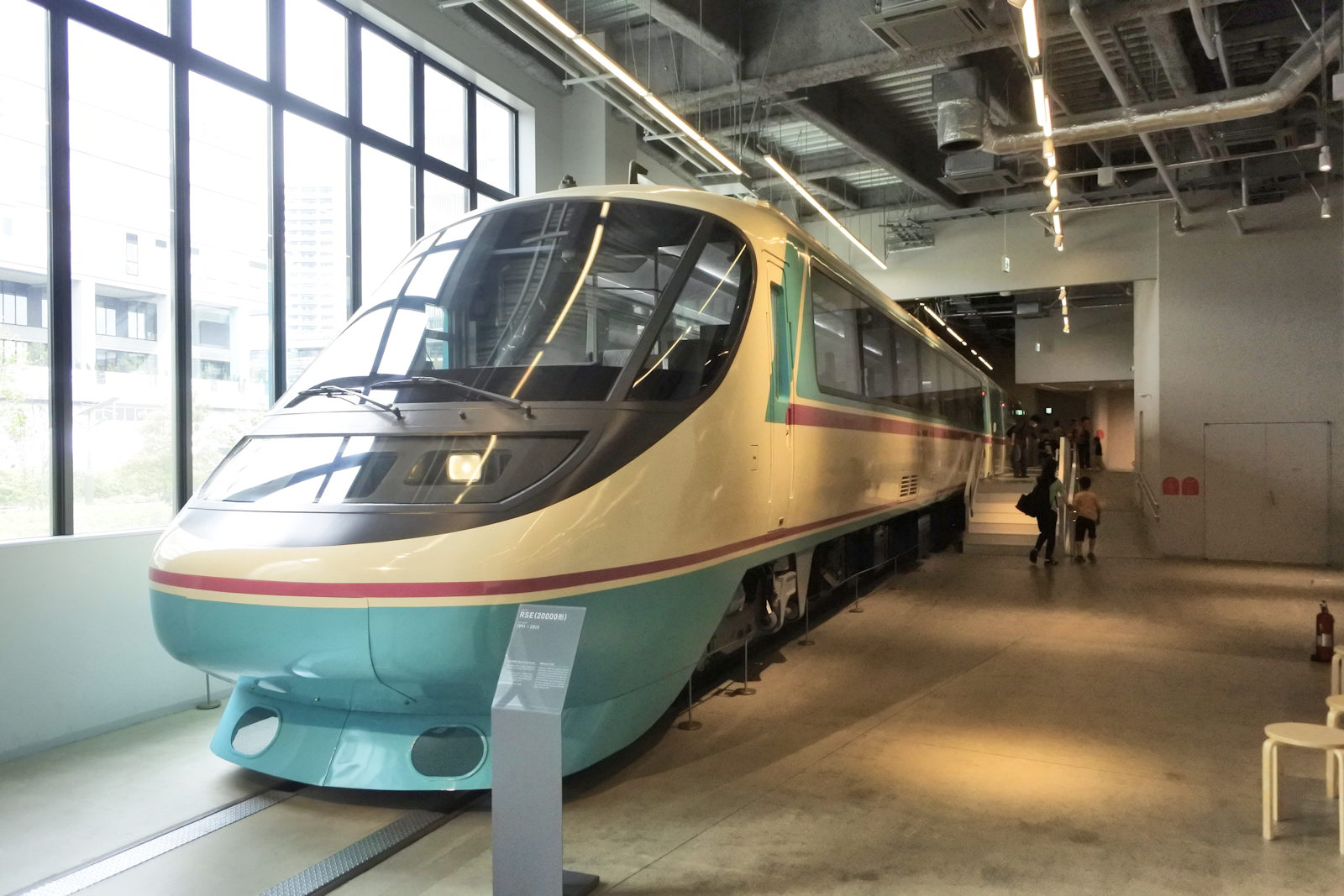
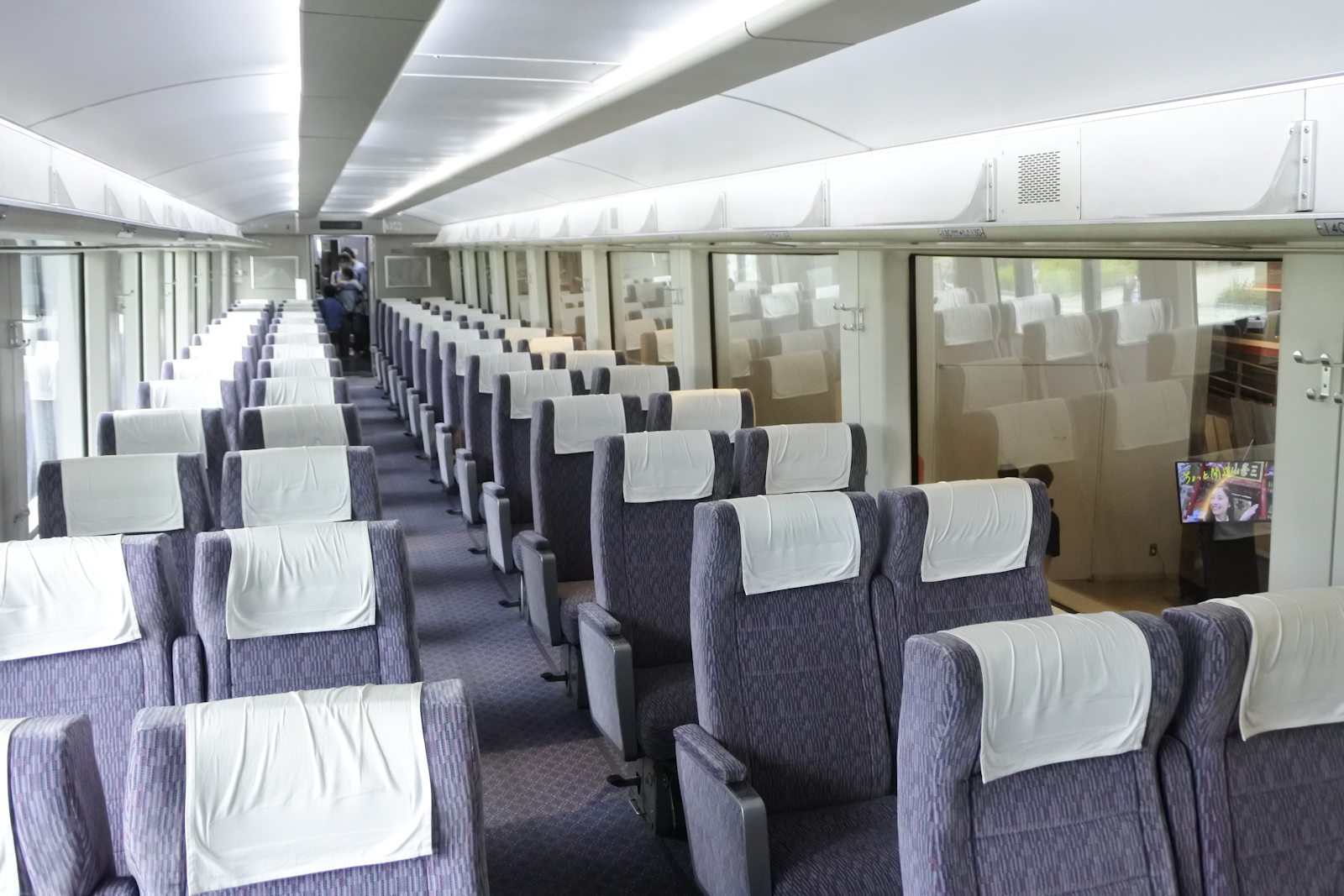
20000形電車先頭車両の座席 Regular-class cabin of 20000 Series
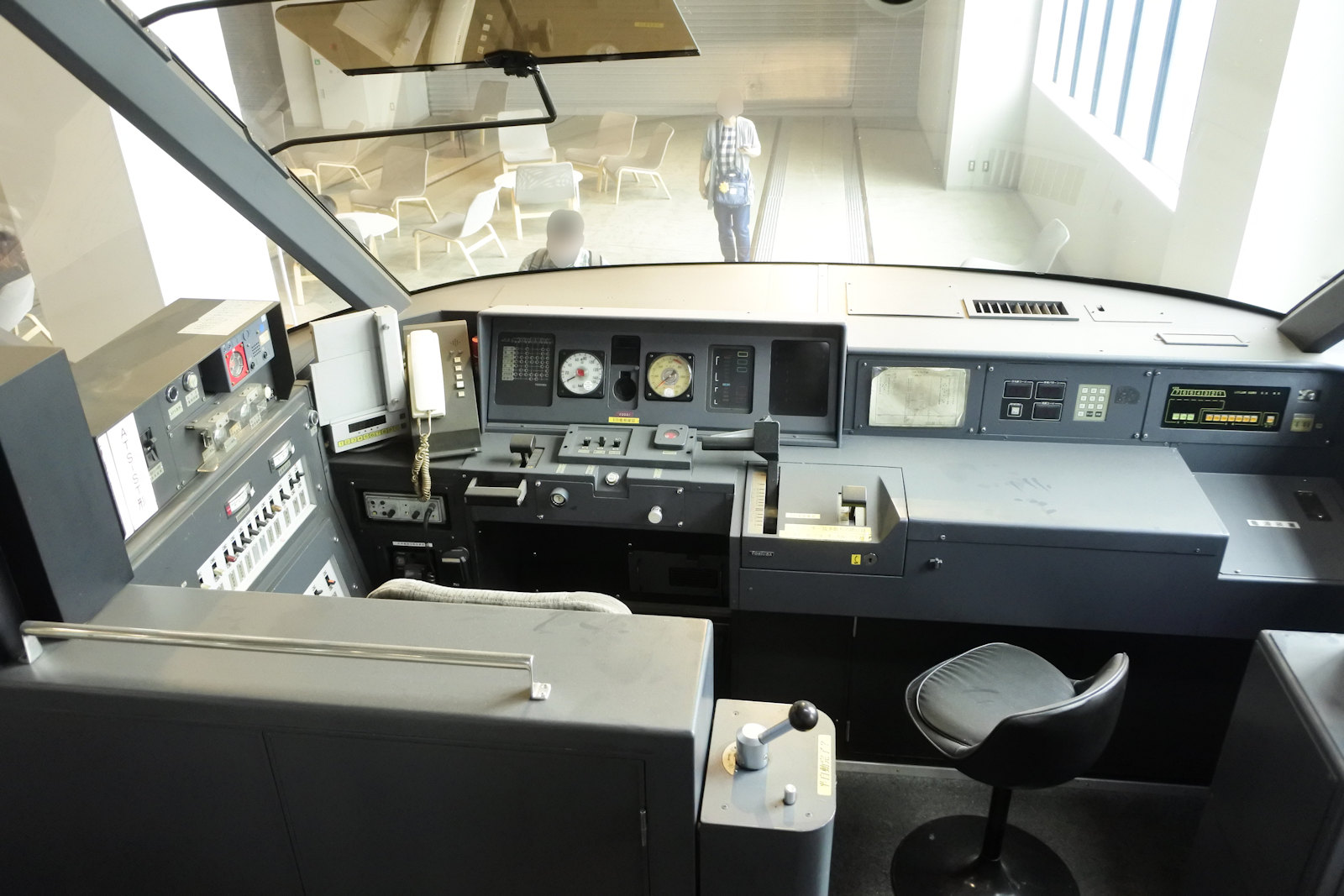
20000形電車乗務員室 Driver's cab of 20000 Series
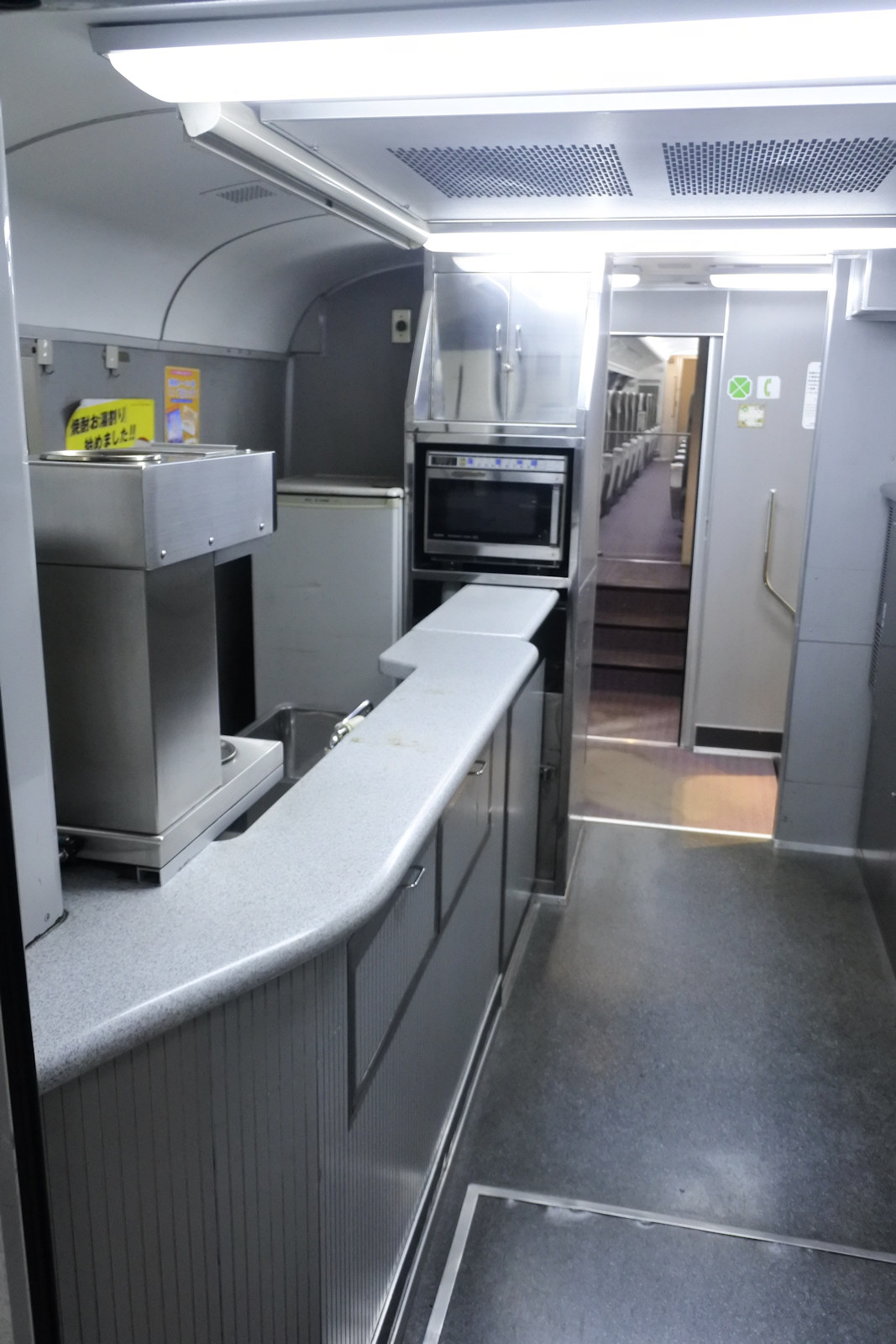
20000形電車のダブルデッカー車両平屋部分の車販カウンター kitchen and service counter of 20000 Series on the flat floor of a double-decker carriage of 20000 Series
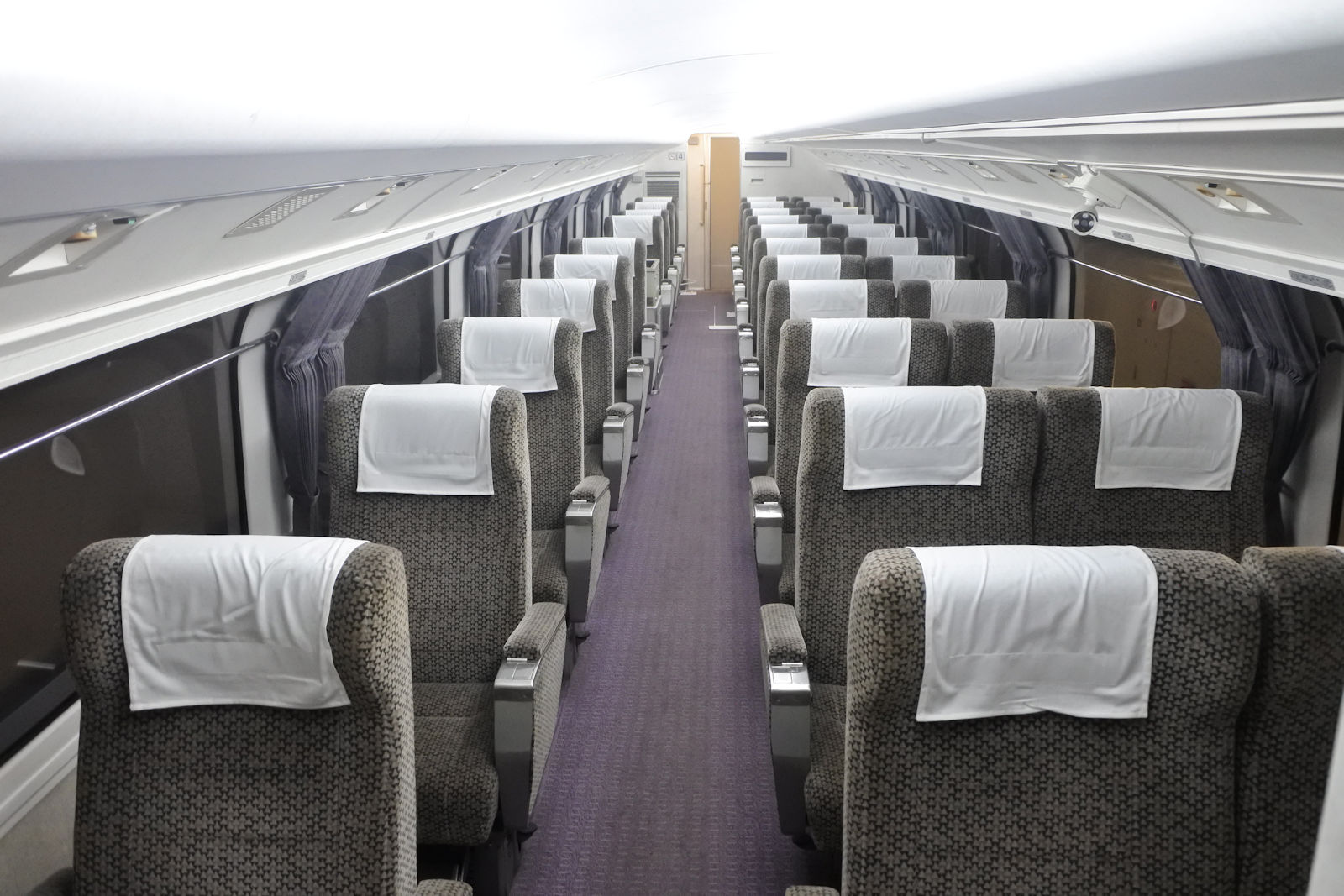
20000形電車のダブルデッカー車両2階のスーパーシート(JRのグリーン車相当) first-class cabin on the upper deck of a double-decker carriage of 20000 Series
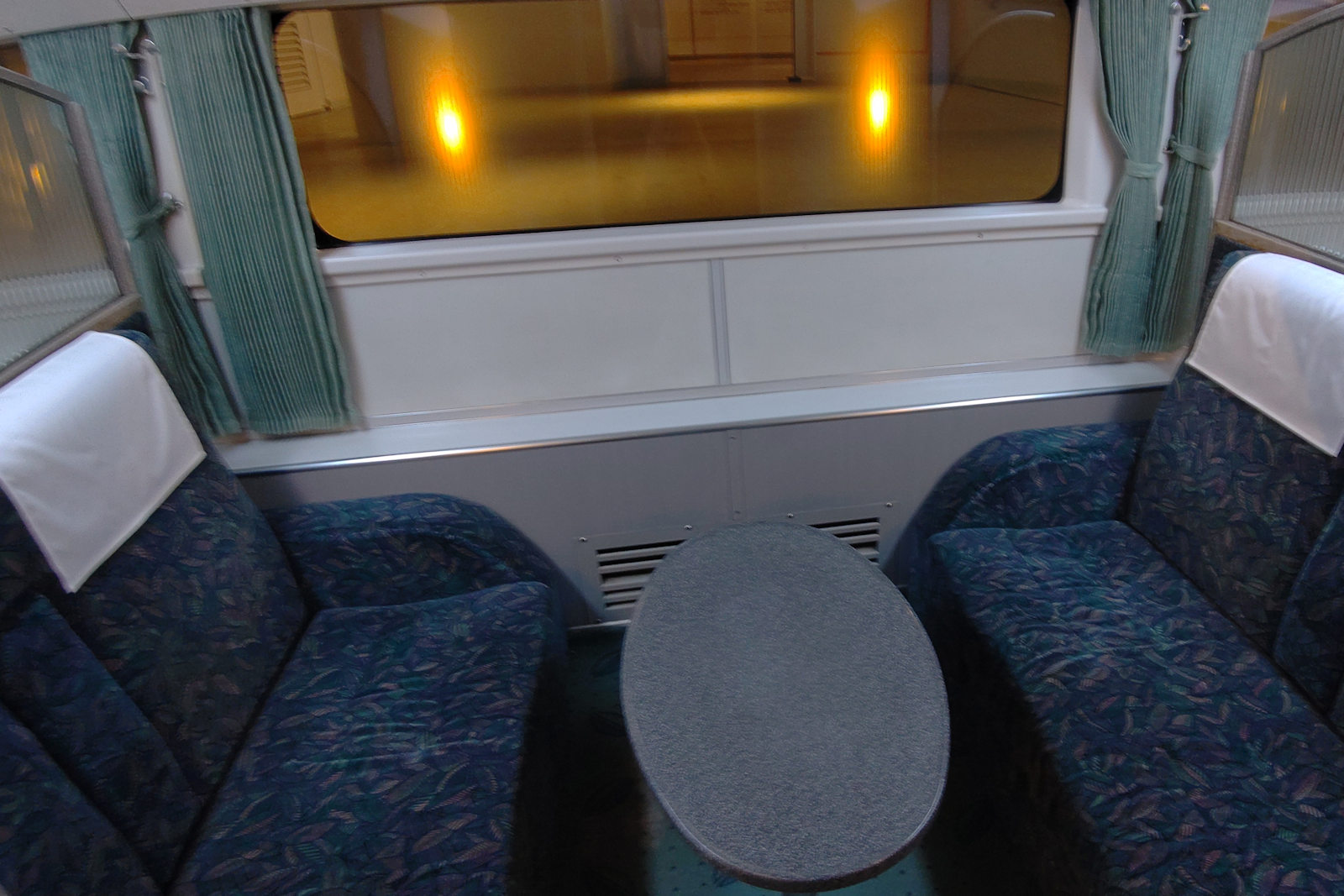
20000形電車のダブルデッカー車両1階のセミコンパートメント semi-open compartment on the lower deck of a double-decker carriage of 20000 Series
再び2階に上がると、そこには鉄道模型のジオラマが広がる「ジオラマパーク」。
新宿・海老名・江ノ島・箱根など小田急線・箱根登山鉄道鉄道線の駅とその周辺の街並みが再現されている。
新宿駅はJR東日本各線ホームとの境界を仕切る四つ葉形のガラスが特徴的な壁がしっかりと再現されている。新宿駅周辺には小田急百貨店(新宿西口ハルク)や新宿ミロード、東京都庁舎などが建つ。

模型で再現された新宿駅周辺の街並み Miniature model depicting Shinjuku Station
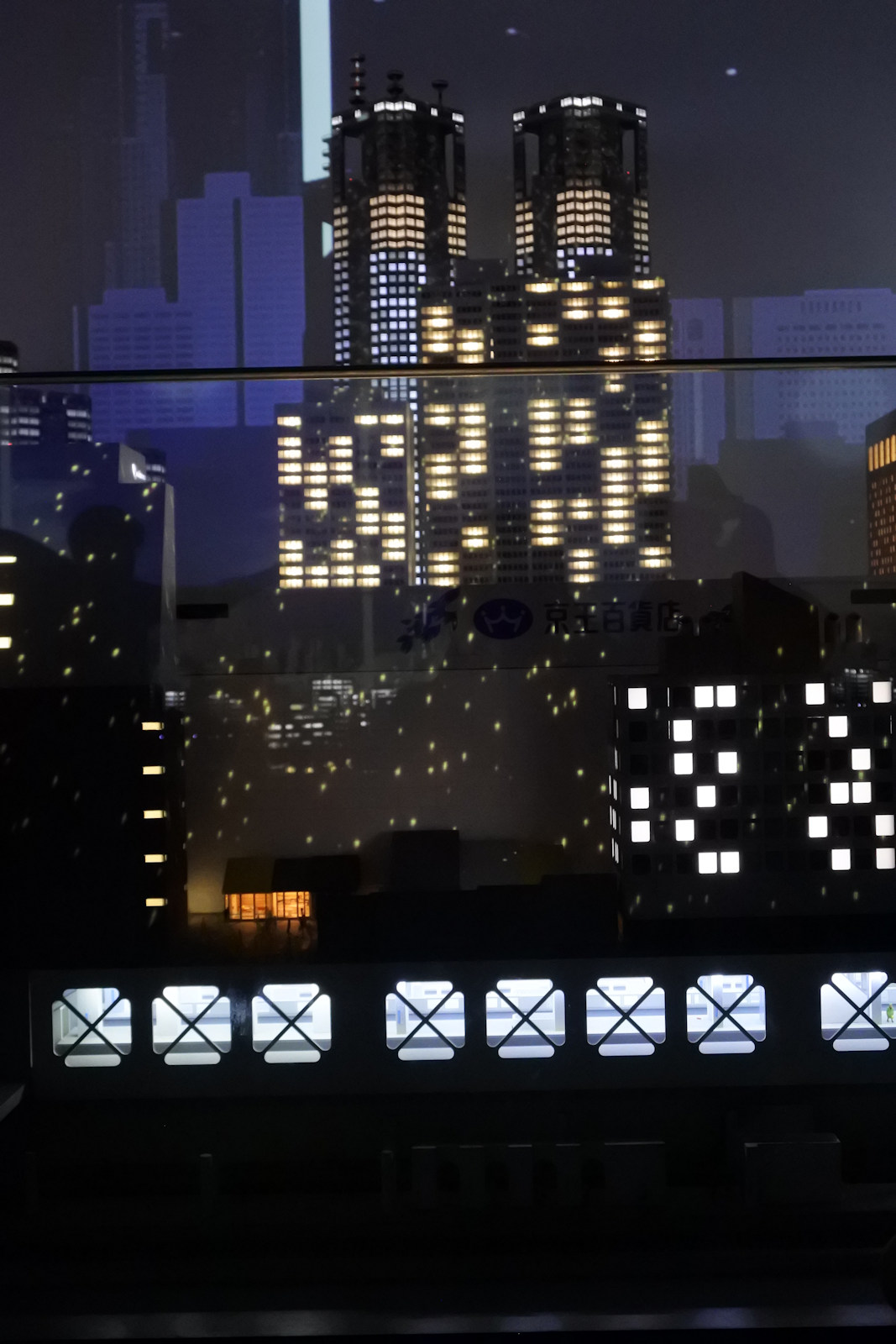
模型で再現された新宿駅の壁と東京都庁 Miniature model depicting the wall at Shinjuku Station and Tokyo Metropolitan Government building
片瀬江ノ島駅は竜宮城風の駅舎がきちんと再現され、江ノ島には江島神社とシンボルである江ノ島シーキャンドルがそびえ立つ。
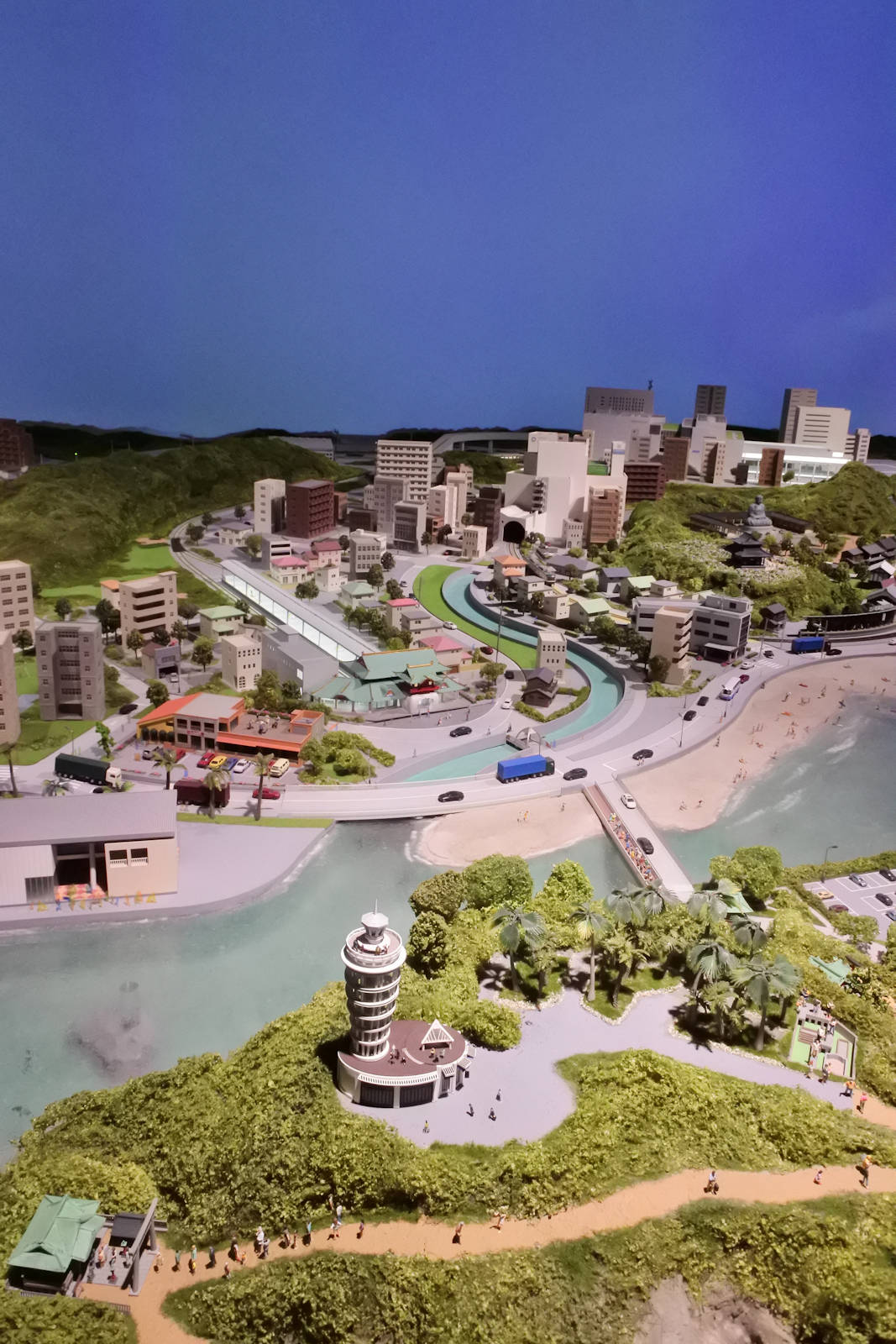
模型で再現された江ノ島と片瀬江ノ島駅 Miniature model depicting Enoshima Island and Katase-enoshima Station
箱根湯本駅の前の道では、毎年1月2日・3日の風物詩となっている箱根駅伝(東京箱根間往復大学駅伝競走)のランナーたちが走る演出も用意されている。箱根湯本駅からは箱根登山鉄道鉄道線の線路が伸び、スイッチバックも再現されている。最も奥には芦ノ湖が再現され、箱根海賊船「クイーン芦ノ湖」が湖上を航行している。

模型で再現された箱根湯本駅と箱根駅伝 Miniature model depicting Hakone-yumoto Station and Hakone Ekiden intercollegiate relay race
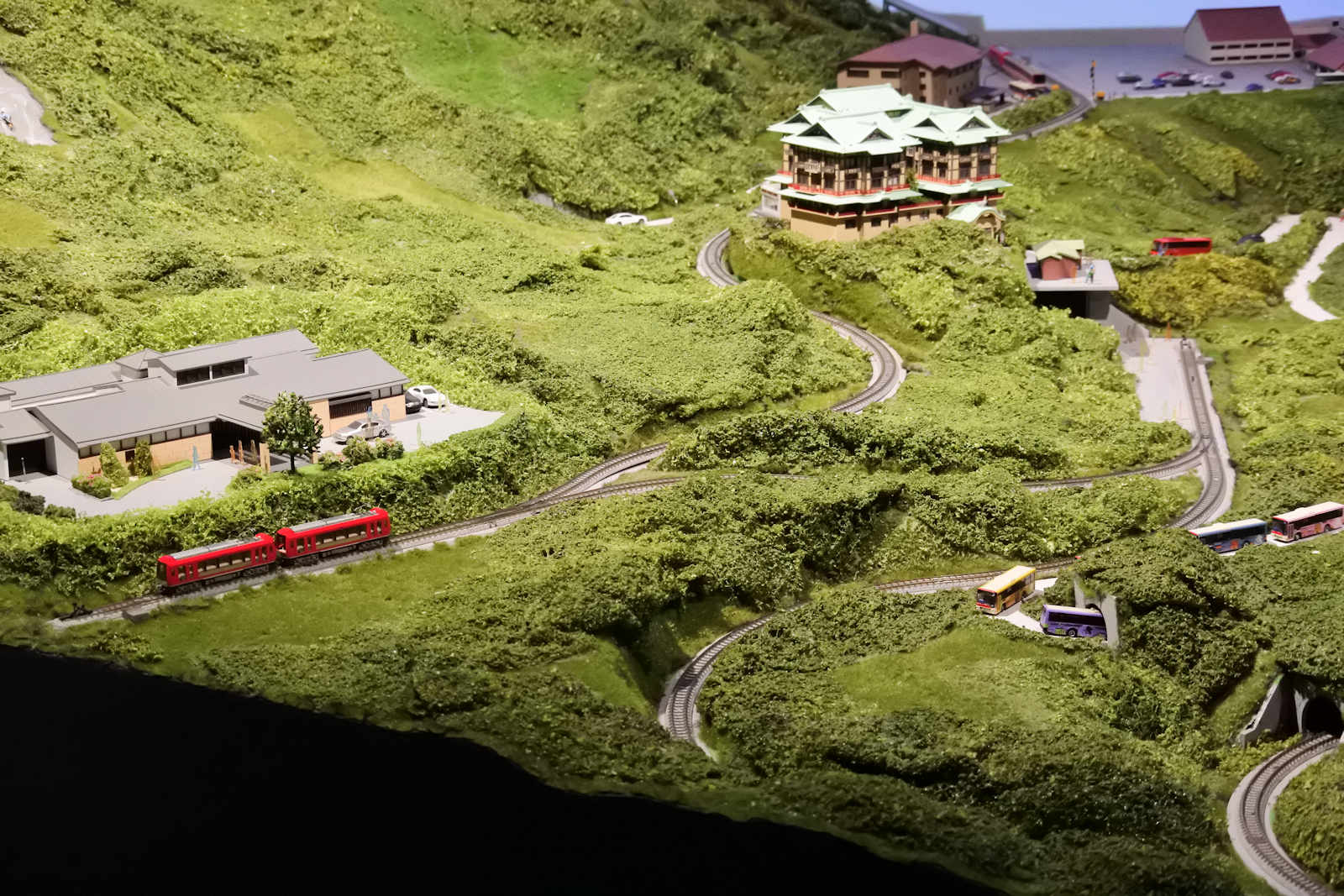
模型で再現された箱根登山鉄道鉄道線 Miniature model depicting Hakone Tozan Line
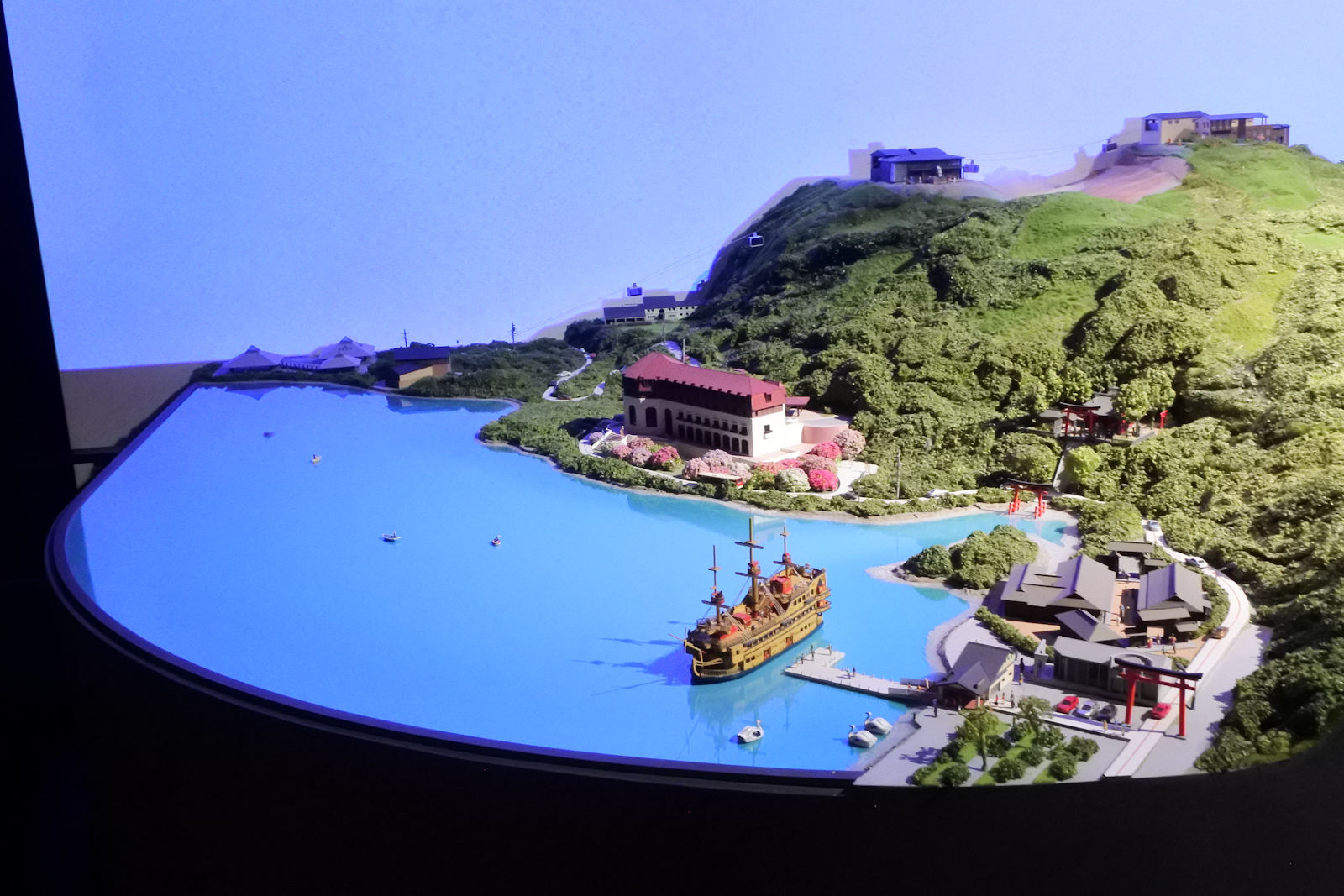
模型で再現された芦ノ湖 Miniature model depicting Lake Ashi
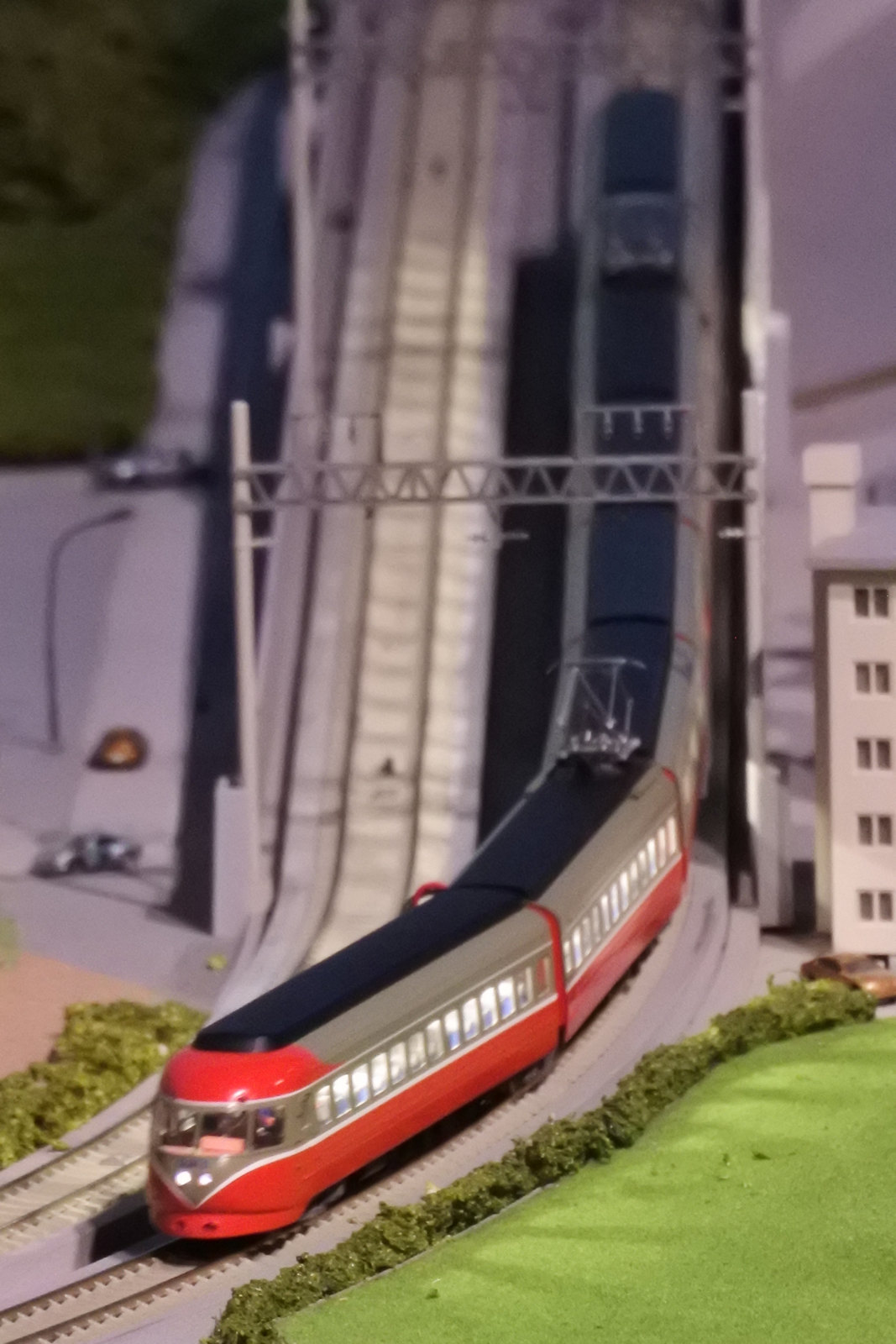
ジオラマを走る初代3000形電車の模型 model train of first 3000 Series
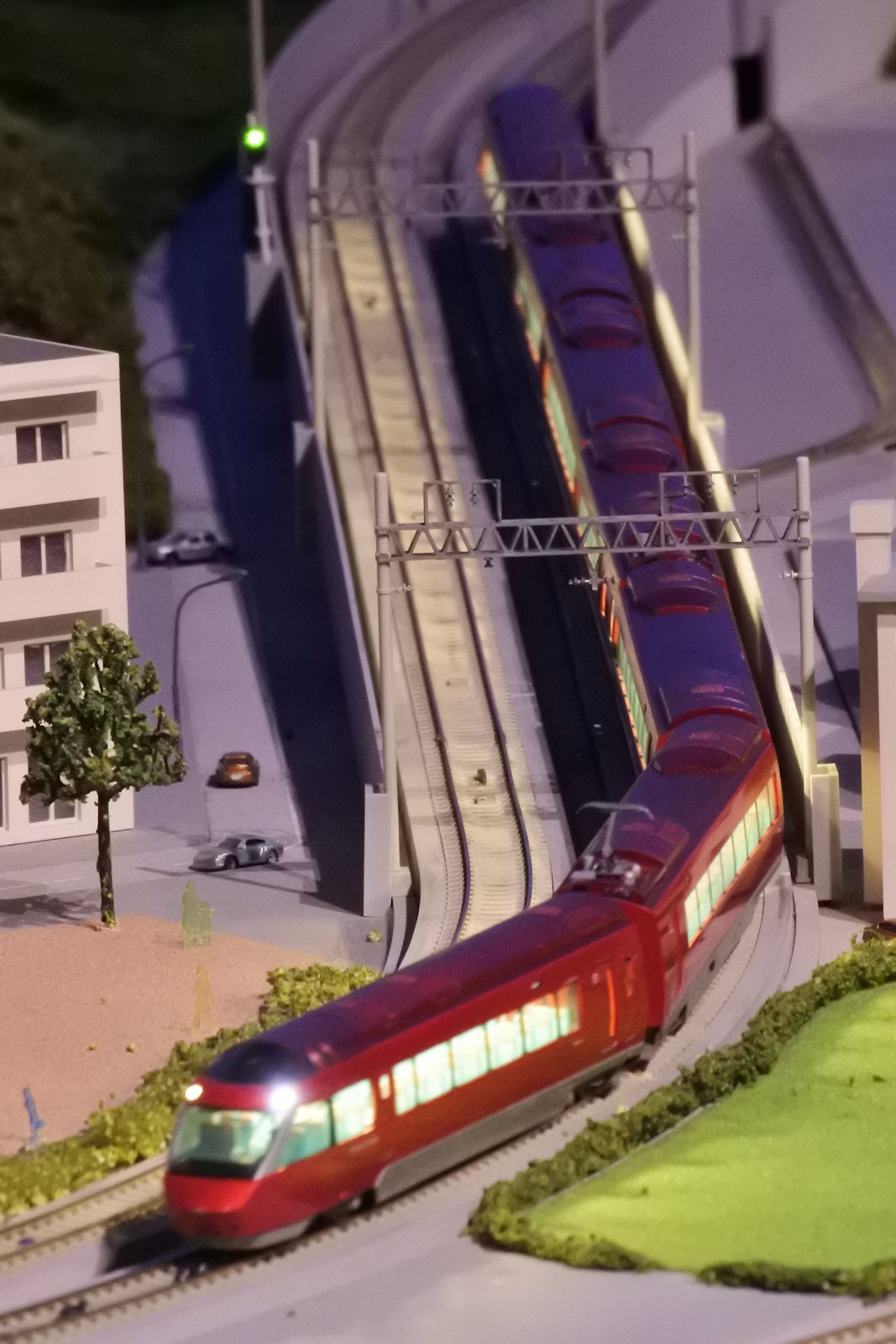
ジオラマを走る70000形電車の模型 model train of 70000 Series
最後に、屋上の「ステーションビューテラス」へ。海老名駅や海老名検車区を、椅子に座りながらのんびりと過ごせる。この時は、検車区に入庫中の30000形電車がと営業運転中の60000形電車が見られた。

「ステーションビューテラス」 View from roof balcony
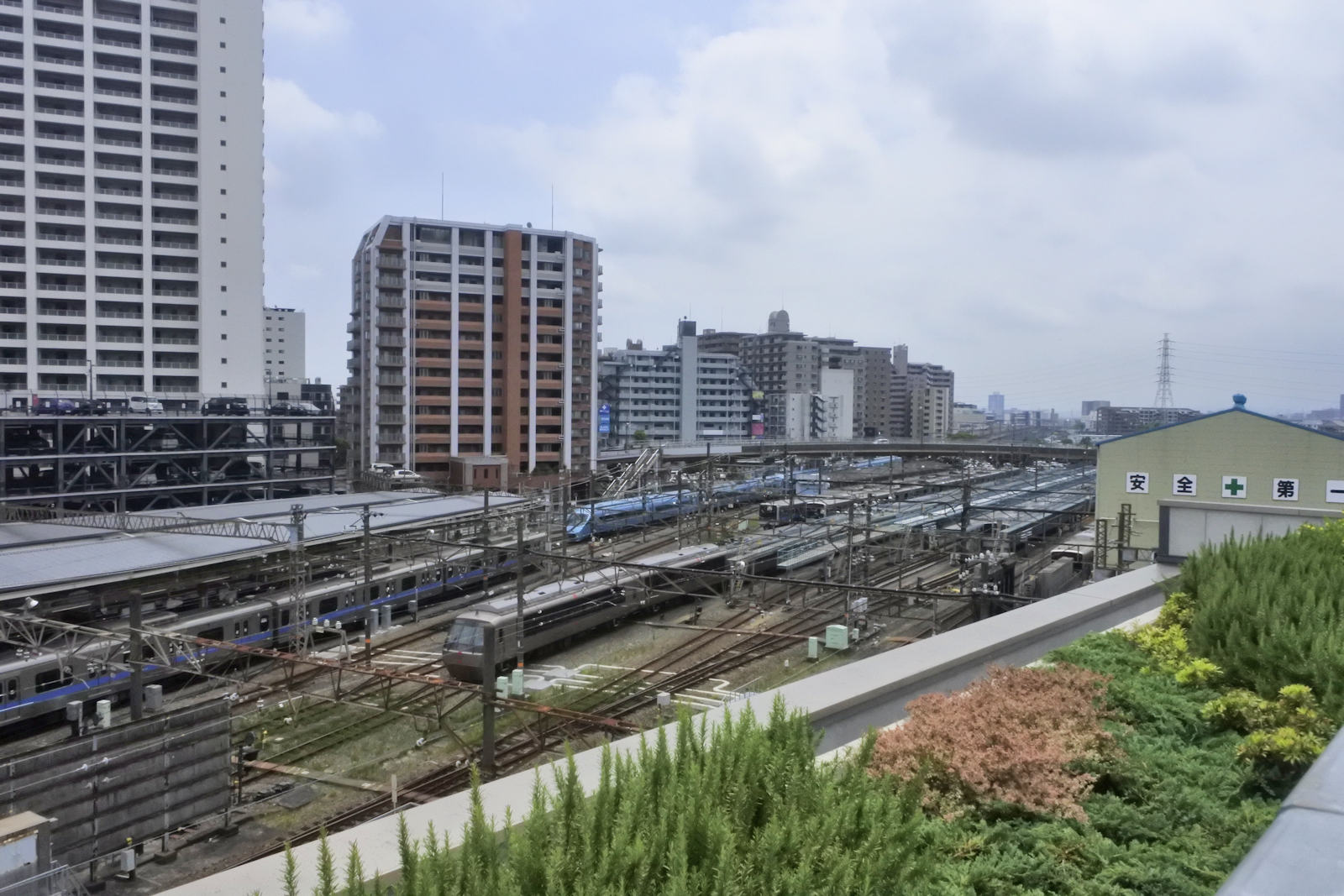
「ステーションビューテラス」から見える小田原線の列車 trains on Odawara Line from the roof balcony
2階へ降り、再び「ROMANCECAR MUSEUM CLUBHOUSE」へ。
前述のとおり5月31日で閉店してしまうため、ランチもここで食べることにした。僕は「RMC ゼロミートベジバーガー」と「飲める車両図鑑」をオーダーした。
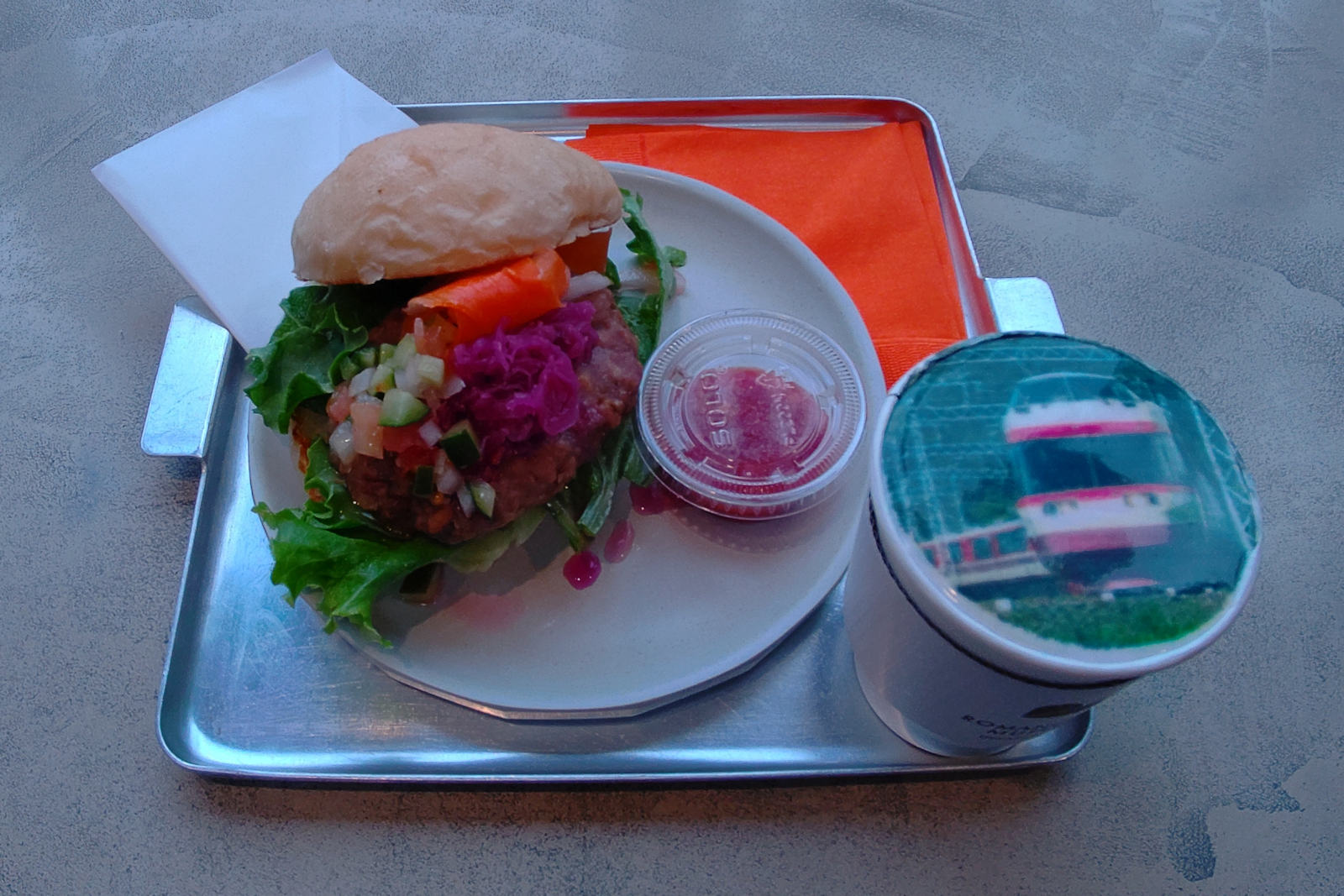
「RMC ゼロミートベジバーガー」と「飲める車両図鑑」 soy meat hamburger and a cup of hot chocolate
「RMC ゼロミートベジバーガー」はゼロミート(大塚食品が製造・販売する大豆ミート)で作ったハンバーグと小田急線沿線で獲れた野菜(レタス・ニンジン・紫キャベツ)を挟んだハンバーガー。
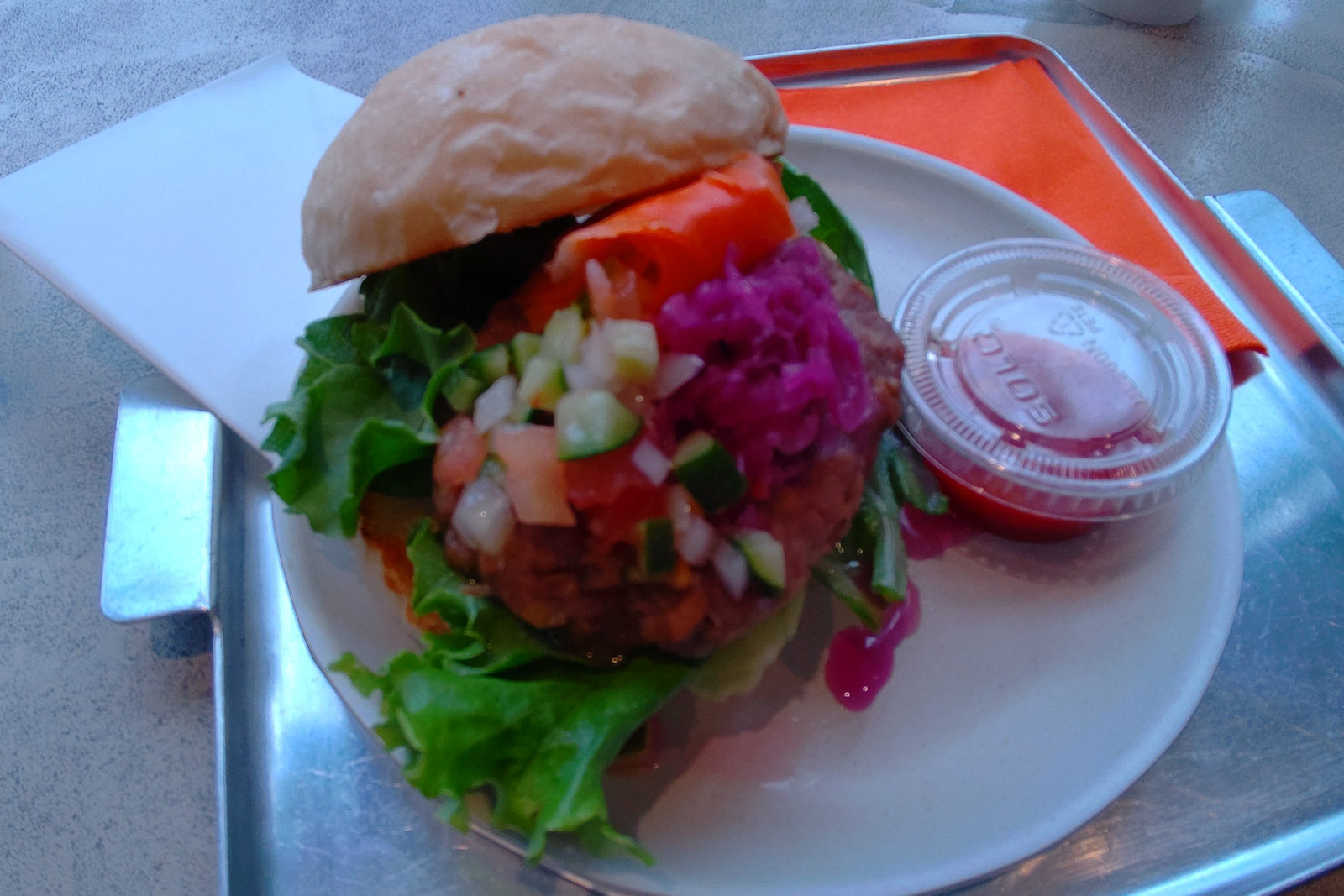
「飲める車両図鑑」はミュージアムに展示されているロマンスカー各車種の写真がプリントされたドリンクで、コーヒーとココアから選べる。僕は、僕が1番思い入れのある車両である10000形のホットココアをチョイス。クリームの上に写真がきれいに描かれていることに驚いた。
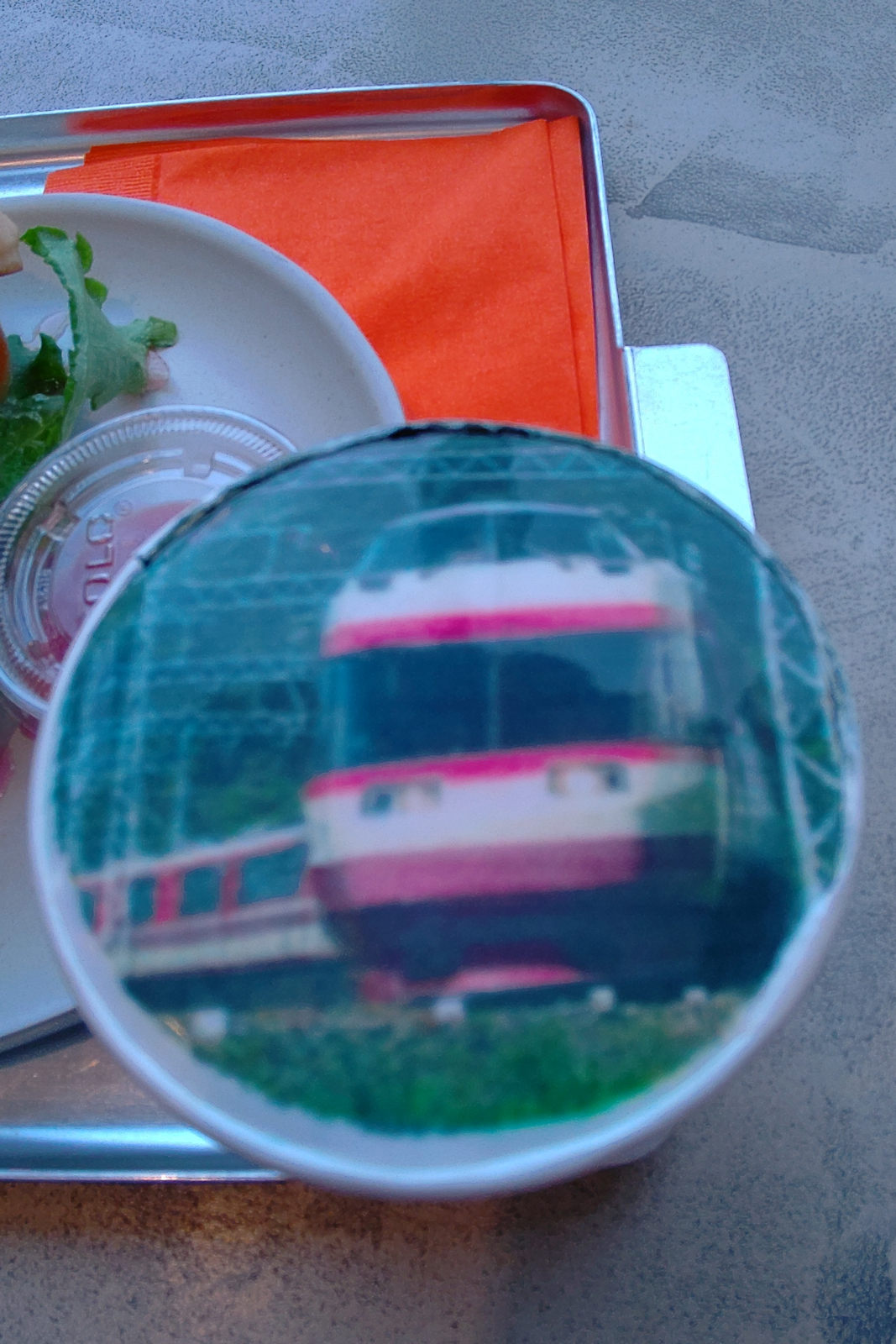
僕は箱根へ行くときに何度も小田急ロマンスカーに乗り、展望席も好きなことから、「ロマンスカーミュージアム」には2021(令和3)年に開館以来、ぜひ1度行きたかった。クールケーキや「飲める車両図鑑」にはありつけることはもうできなさそうだが、懐かしのロマンスカーを間近に見ることができるため、僕はもう1回行きたくなった。
ロマンスカー好きなら何度行っても楽しめるミュージアムと言えるだろう。
On May 21st, I went to see Romancecar Museum, which shows Odakyu Romancecar carriages, in Ebina City, Kanagawa Prefecture.
Because of COVID-19 spread, visitors needed a booking before coming there since its opening in 2021. However, the walk-up ticket started to sell in October, 2022.
I saw some families waiting for museum tickets on the "ViNAWALK" pedestrian deck, crossing over the Stations on Odakyu Odawara Line, JR East Sagami Line, and the museum.
First, I went to the "ROMANCECAR MUSEUM CLUBHOUSE" cafe to eat a piece of "Cool Cake" Swiss roll filled with ice cream topped with fruits. It was served in Romancecar trains until 1993. Because I hadn't eaten the cake while on board, I wanted to eat it.
I wanted to visit the museum before May 31st because I heard an announcement that the cafe would finish its service. I found interest in the gap between soft sponge cake and hard ice cream.
After eating the cake, I went down to the ground/first floor to see the exhibition. In the "History Theater" area, an 1 Series, the first carriage on Odakyu Odawara Line, was exhibited.
Coming to the "Romancecar Gallary" area, I saw three types of Romancecar Carriages (first 3000, 3100, and 7000 Series). The exhibited 3000 Series are the three carriages of the five I saw at an event in 2019. Before the museum opened, those were preserved at a carriage shed in nearby Ebina Railyard. Though the set is shortened to three carriages, it still has an atmosphere of the old time.
3100 Series is also exhibited as a three-carriage set. The visitors can overview the cabins of the two sets from the end sections near the doors of the second carriage.
The exhibited 7000 Series is only a front carriage, and visitors can't see its interior.
Going over the three, a front carriage of 10000 Series and two carriages of 20000 Series are exhibited. The visitors can see the whole of the cabins and sit on the seats of both front carriages. The visitors can also look around some parts of a double-decker carriage of 20000 Series, such as a kitchen and service counter, lower-deck semi-open compartments from an aisle, and an upper-deck "Super Seat" first-class cabin from the end of the stairs.
Going up the other stairway to the first/second floor again, I came to "Diorama Park", which consists of miniatures of scenery along Odakyu Lines, such as Shinjuku, Hakone, and Enoshima, with model trains.
The Shinjuku Station in the diorama copied the wall with characteristically shaped glasses bordering Odakyu and JR. Around here, the Odakyu Department Store (HALC Shinjuku West), Shinjuku MYROAD Department Store, and Tokyo Metropolitan Government building stand.
In the Enoshima area, Katase-enoshima Station looking like the Ryugu-jo (Dragon Palace), the underwater dwelling in the Urashima Taro fable, copied. Enoshima Shrine pavilion and Enoshima Sea Candle lighthouse stand on the top of Enoshima Island.
In the Hakone area, dolls of some athletes move on a roadway in front of Hakone-yumoto Station, which depicts the Hakone Ekiden intercollegiate relay race on January 2nd and 3rd. From Hakone-yumoto Station, Hakone Tozan Line spreads to the middle of the mountains with switchbacks. At the end of the diorama, a cruising ship, "Queen Ashinoko", on Lake Ashi, comes and goes.
I went to the roof balcony, where the visitors could watch the trains in service or at the railyard. I saw a 30000 Series set staying at the yard and a 60000 Series set in service.
At last, I came to the cafe again to eat lunch. I chose a soy meat hamburger and a cup of hot chocolate topped with cream, on which a picture of a Romancecar carriage was printed. I was surprised at the quality of it on the cream.
I enjoyed my first visit to the museum. I want to do it again because I can see the Romancecar carriages closely.
If you love Romancecar, I strongly recommend visiting.
お気に入りの記事を「いいね!」で応援しよう
[鉄道日記] カテゴリの最新記事
-
お台場開催の鉄道フェスティバルへ Oct 13, 2024 コメント(2)
-
東急5050系5178Fを撮る Jun 26, 2024 コメント(2)
-
東急5050系「新幹線デザインのラッピング… Jun 26, 2024
【毎日開催】
15記事にいいね!で1ポイント
10秒滞在
いいね!
--
/
--
© Rakuten Group, Inc.








